The Jackson Hole Economic Symposium, held each year in the stunning natural setting of Wyoming, is a highly anticipated event among economists, policymakers, and investors. Against the backdrop of the majestic Teton mountains, attendees gather to hear the latest insights from influential speakers, including the chair of the Federal Reserve. This year, on August 23rd, Jerome Powell took the stage to deliver his annual address, and his message was clear: the Federal Reserve is prepared to start lowering interest rates after a period of increases.
For economists and investors who spend their days analyzing charts and graphs, the rugged peaks of the Teton mountains may bring to mind the ups and downs of financial markets. Just as they study the trends and patterns of economic indicators, they can see the similarities between the jagged lines of the mountains and the fluctuating data points on their screens. The backdrop of the symposium, with its sweeping vistas and sense of grandeur, serves as a reminder of the vast forces at play in the global economy.
The decision to raise or lower interest rates is one of the most critical tools in the Federal Reserve’s arsenal for managing the economy. By adjusting the cost of borrowing, the Fed can influence consumer spending, business investment, and overall economic activity. In recent years, the central bank under Powell’s leadership had been steadily raising rates in response to a strong economy and low unemployment. However, mounting trade tensions and slowing global growth have raised concerns about the sustainability of this path.
Powell’s speech at Jackson Hole signaled a shift in the Fed’s stance, acknowledging the changing economic landscape and the need for a more accommodative policy. The decision to lower rates is aimed at supporting continued economic expansion, mitigating risks from trade uncertainty, and maintaining price stability. While the exact timing and magnitude of rate cuts remain uncertain, Powell’s remarks set the stage for a careful and data-driven approach in the coming months.
The symposium itself serves as a forum for discussion and debate among leading experts in economics and finance. Attendees come from around the world to exchange ideas, share research, and engage in thoughtful analysis of current issues. In addition to the keynote address by Powell, the agenda typically includes presentations on a wide range of topics, from monetary policy to financial regulation to international trade.
As the sun sets behind the Teton mountains, casting a golden glow over the valley, participants at the symposium will continue their conversations over dinner and networking events. The informal setting of Jackson Hole allows for informal interactions and brainstorming sessions, fostering collaboration and innovation among attendees. Amidst the natural beauty of the surroundings, ideas flow freely, and new connections are made that can lead to future research collaborations or business partnerships.
In conclusion, the Jackson Hole Economic Symposium is a unique and influential gathering that brings together thought leaders from across the globe to discuss, debate, and shape the future of economic policy. Against the backdrop of the Teton mountains, Jerome Powell’s speech on interest rates set the tone for a new direction in monetary policy, signaling the Fed’s readiness to respond to changing economic conditions. As economists and investors reflect on the implications of this shift, they will continue to monitor the data, analyze the trends, and seek opportunities to navigate the ever-changing landscape of the global economy.



